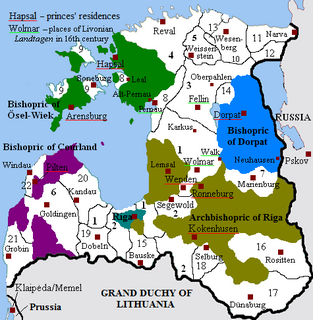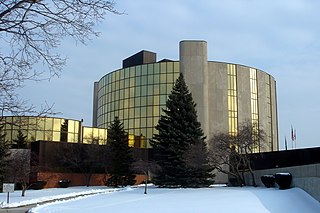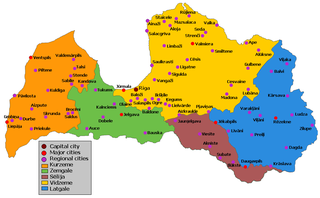
Livonia is a historical region on the eastern shores of the Baltic Sea. It is named after the Livonians, who lived on the shores of present-day Latvia.

Livonia is a city in the northwest part of Wayne County in the U.S. state of Michigan. It is a large suburb of Detroit, with an array of traditional neighborhoods connected to the metropolitan area by freeways. The population was 96,942 at the 2010 census, making it Michigan's ninth largest municipality.

Livonia is a town in Livingston County, New York, United States. As of the 2010 census, the town population was 7,809. The town contains a village also named Livonia. The town is on the eastern border of the county.

The Treaty or Peace of Oliva of 23 April (OS)/3 May (NS) 1660 was one of the peace treaties ending the Second Northern War (1655-1660). The Treaty of Oliva, the Treaty of Copenhagen in the same year, and the Treaty of Cardis in the following year marked the high point of the Swedish Empire.

The Livonian Chronicle of Henry is a document in Latin describing historic events in Livonia and surrounding areas from 1180 to 1227. It was written ca. 1229 by a priest named Henry. Apart from the few references in the Primary Chronicle compiled in Kievan Rus' in the twelfth century, it is the oldest known written document about the history of Estonia and Latvia.

Alexander Theodor von Middendorff was a zoologist and explorer of Baltic German and Estonian extraction.

The Duchy of Livonia, also referred to as Polish Livonia or Livonia was a territory of the Grand Duchy of Lithuania and later the Polish–Lithuanian Commonwealth that existed from 1561 to 1621. It corresponds to the present-day areas of northern Latvia and southern Estonia.

The Inflanty Voivodeship, or Livonian Voivodeship, also known as Polish Livonia, was an administrative division and local government in the Polish–Lithuanian Commonwealth, since it was formed in the 1620s out of the Wenden Voivodeship and lasted until the First Partition of Poland in 1772. The Inflanty Voivodeship was one of the few territories of the Polish–Lithuanian Commonwealth to be ruled jointly by Poland and Lithuania.

The Livonian War (1558–1583) was fought for control of Old Livonia, when the Tsardom of Russia faced a varying coalition of the Dano-Norwegian Realm, the Kingdom of Sweden, and the Union of the Grand Duchy of Lithuania and the Kingdom of Poland.

Coat of arms of Republic of Latvia was officially adopted by the Constitutional Assembly of Latvia on July 15, 1921, and was in official use from August 19, 1921. It was created using new national symbols and elements of coats of arms of Polish and Swedish Livonia and of the Duchy of Courland and Semigallia. Thus the coat of arms combines symbols of Latvian national statehood, as well as symbols of its historical regions. The Latvian national coat of arms was designed by the Latvian artist Rihards Zariņš.

Vidzeme is one of the Historical Latvian Lands. The capital of Latvia, Riga, is situated in the southwestern part of the region. Population: around 1.3 million (year?). Literally meaning "the Middle Land", it is situated in north-central Latvia north of the Daugava River. Sometimes in German, it is also known as Livland, the German form from Latin Livonia, though it comprises only a small part of Medieval Livonia and about half of Swedish Livonia.

Ikšķile is a town in Latvia, the administrative centre of Ikšķile municipality. It was the first capital of the Roman Catholic Bishopric of Livonia, known by the German name of Üxküll. Saint Meinhard, known from the Livonian Chronicle of Henry, was the first bishop of Üxküll. In 1197 Berthold of Hanover, a Cistercian abbot of Loccum, was made the second bishop of Üxküll. Those days the town was the center of the upcoming crusading activities in the Livonian area. Bishop Berthold moved the episcopal see to Riga, but was killed by the Livs in battle.

Il falegname di Livonia, o Pietro il grande, czar delle Russie is an 1819 opera buffa in two acts with music by Gaetano Donizetti set to a libretto by Gherardo Bevilacqua-Aldobrandini. The libretto was based in part on Felice Romani's libretto for Giovanni Pacini's opera Il falegname di Livonia, which had just been presented at La Scala in Milan on 12 April 1819. Another source was Alexandre Duval's comedy Le menuisier de Livonie, ou Les illustres voyageurs (1805).
Livonia Marketplace is an open-air shopping mall in the Detroit suburb of Livonia, Michigan. Opened in 2010, the center is anchored by Kohl's and Walmart. It occupies the site of the former Livonia Mall, which was an enclosed mall built in 1964. Livonia Mall lost the majority of its tenants in the 2000s, including its previous anchor stores of Crowley's, Sears, Mervyns, and Children's Palace. The mall was closed in May 2008, with only the Sears remaining from the original property. Sears closed in April 2020.

Inhabitants of Saaremaa, refers to people historically living on the island of Saaremaa, an island in Estonia in the Baltic Sea. In modern Estonian, they are called saarlased. In Viking-Age literature, the inhabitants were often included under the name "Vikings from Estonia". The name Oeselians was first used by Henry of Livonia in the 13th century. The inhabitants are often mentioned in the historic written sources during the Estonian Viking Age.
On, On, U of K, also punctuated as "On! On! U of K", is a fight song at the University of Kentucky. Although it is primarily associated with the historically successful Kentucky Wildcats men's basketball program, the lyrics are actually specific to football. Aside from this song, the school is rarely referred to as "U of K" but simply as "UK."

Greenmead Historical Park, also known as Greenmead Farms, is a 3.2-acre (1.3 ha) historic park located at 38125 Base Line Rd., Livonia, Michigan. It includes the 1841 Greek Revival Simmons House, six other structures contributing to the historic nature of the property, and additional buildings moved from other locations. Greenmead Farms was designated a Michigan State Historic Site in 1971 and listed on the National Register of Historic Places in 1972.

Livonia Rock is a rock lying 0.5 nautical miles (1 km) south of Cape Melville, the eastern extremity of King George Island, in the South Shetland Islands, Antarctica. It was named by the UK Antarctic Place-Names Committee in 1960 for the sealing vessel Livonia from London, which visited the South Shetland Islands in 1821–22.

Henry of Latvia (Latin: Henricus de Lettis, German: Heinrich von Lettland, Latvian: Latviešu Indriķis, Estonian: Läti Henrik;, also known in the English-speaking world as Henry of Livonia, was a priest, missionary and historian. He wrote the Livonian Chronicle of Henry which describes the evangelization of the regions which are now part of Estonia and Latvia during the Northern Crusades.

Terra Mariana was the official name for Medieval Livonia or Old Livonia. It was formed in the aftermath of the Livonian Crusade, and its territories were composed of present-day Estonia and Latvia. It was established on 2 February 1207, as a principality of the Holy Roman Empire, but lost this status in 1215 when Pope Innocent III proclaimed it as directly subject to the Holy See.

















